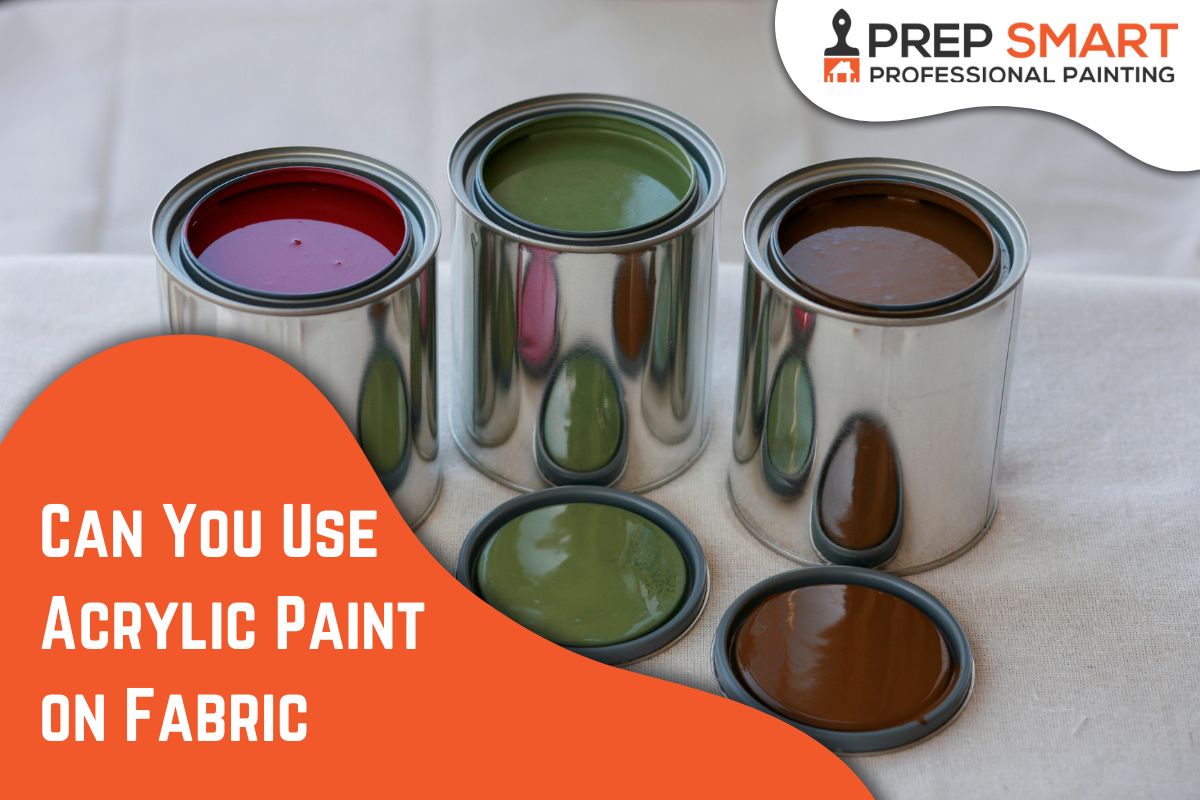
Can You Use Acrylic Paint on Fabric
Acrylic paint is a versatile and popular choice for various art projects. But can you use acrylic paint on fabric? The answer is a resounding yes! In this guide by Prep Smart Painting, we’ll explore how to use acrylic paint on fabric effectively. We’ll cover everything from preparation and application to care tips to ensure your designs last. With the right techniques, your fabric projects will turn out beautifully and stand the test of time.
Understanding Acrylic Paint
Acrylic paint is a popular medium for various art projects due to its versatility and vibrant colors. In this section, we’ll delve into what acrylic paint is and why it’s an excellent choice for fabric.
What is Acrylic Paint?
Acrylic paint is a water-based paint made from pigment and acrylic polymer emulsion. It is known for its quick-drying properties and becomes water-resistant once dry, making it a favorite among artists for a wide range of applications.
Why Use Acrylic Paint on Fabric?
- Versatile: Acrylic paint comes in a wide range of colors, allowing for limitless creative possibilities.
- Good Adhesion: With proper preparation, acrylic paint adheres well to fabric, ensuring your designs stay put.
- Durable and Flexible: Once dry, acrylic paint is both durable and flexible, making it ideal for fabric projects. This flexibility ensures the paint moves with the fabric, reducing the risk of cracking.
- Easy to Use: Acrylic paint is user-friendly, making it suitable for artists of all levels.
- Cost-Effective: Compared to other fabric-specific paints, acrylic paint is often more affordable while still delivering excellent results.
- Customizable: You can mix acrylic paint with textile mediums to enhance its performance on fabric, such as improving softness and reducing stiffness.
By understanding the properties of acrylic paint and why it is suitable for fabric, you can confidently embark on your fabric painting projects with the knowledge that your creations will be vibrant, durable, and long-lasting.
Preparing the Fabric
Proper preparation is key to ensuring that acrylic paint on fabric adheres well and lasts long. In this section, we’ll cover how to choose the right fabric and the importance of pre-washing.
Choosing the Right Fabric
When it comes to painting on fabric with acrylic paint, selecting the right type of fabric is crucial for achieving the best results. Here are the best choices and fabrics to avoid, summarized in a table:
|
Best Choices |
Reasons |
|
Cotton |
Highly absorbent and provides a smooth surface, ensuring vibrant colors and good adhesion of the paint. |
|
Polyester |
Durable synthetic fabric that holds up well with acrylic paint, providing a reliable surface for painting. |
|
Blends |
Combines the benefits of both cotton and polyester, offering a balanced surface that is both absorbent and durable. |
|
Denim |
Sturdy and thick, this fabric can withstand multiple layers of paint without tearing, making it ideal for durable designs. |
Avoid Stretchy Fabrics:
- Spandex: Stretchy fabrics such as spandex should be avoided when using acrylic paint on fabric. These materials can stretch and contract, leading to cracks in the paint. The paint may not adhere properly, resulting in peeling or flaking over time.
Pre-washing
Pre-washing your fabric is an essential step in preparing it for painting. Here’s why it’s important and how to do it properly:
- Remove Chemicals and Sizing: Fabrics often come with chemicals or sizing that can interfere with the paint’s ability to adhere. Washing the fabric beforehand removes these substances, ensuring better adhesion.
- How to Wash: Use a mild detergent and wash the fabric in warm water. Avoid using fabric softeners, as they can leave a residue that hinders paint adhesion.
- Smooth Painting Surface: After washing, it’s important to dry and iron the fabric to create a smooth surface for painting.
- Drying: Let the fabric air dry or use a dryer. Make sure it is completely dry before painting.
- Ironing: Iron the fabric to remove any wrinkles or creases. A smooth surface ensures even application of the paint and prevents unwanted texture in your design.
By pre-washing and properly preparing your fabric, you set the foundation for a successful fabric painting project using acrylic paint. Proper preparation will help your designs look professional, adhere better, and last longer.
Preparing the Paint
Properly preparing your paint is crucial for achieving the best results when using acrylic paint on fabric. Follow these steps to ensure your paint is ready for fabric application.
Using Fabric Medium
Fabric medium is a vital additive that helps acrylic paint adhere better to fabric and stay flexible. Here’s how to use it and its benefits:
1. Mix Acrylic Paint with Fabric Medium:
-
- Combine your acrylic paint with fabric medium in a 1:1 ratio.
- Stir the mixture thoroughly until it is well-blended.
2. Benefits of Fabric Medium:
-
- Flexibility: The fabric medium helps the paint stay flexible once dry, preventing it from cracking.
- Durability: It enhances the durability of the paint on fabric, ensuring your designs last through wear and washing.
- Softness: Fabric medium softens the paint, making it less stiff and more comfortable to wear or use on fabric items.
- Improved Adhesion: It ensures better adhesion of the paint to the fabric, reducing the chances of peeling or flaking.
- Color Retention: Helps maintain the vibrancy of the paint colors after washing and exposure to sunlight.
- Ease of Use: Makes the paint easier to apply smoothly, reducing brush strokes and uneven texture.
Testing Colors
Before applying your paint to your main fabric, it’s essential to test the mixture to ensure the color and consistency are as desired. Follow these steps:
1. Prepare a Fabric Scrap:
-
- Cut a small piece of the same type of fabric you will be painting on.
- This ensures that the test accurately reflects how the paint will behave on your main project.
2. Test the Paint Mixture:
-
- Apply a small amount of the paint mixture to the fabric scrap.
- Let it dry completely to see the true color and finish.
- Check for consistency and flexibility to ensure the paint does not crack or peel.
Planning Your Design
Planning your design is an essential step to ensure your project with acrylic paint on fabric turns out beautifully. Here are some easy-to-follow tips:
1. Sketch Your Design on the Fabric:
-
- Use a Fabric Pencil or Chalk: Choose a light-colored fabric pencil or tailor’s chalk to sketch your design. These tools are easy to remove and won’t interfere with your paint.
- How to Do It:
- Lay your fabric flat on a smooth surface.
- Lightly sketch your design directly onto the fabric. Keep your lines faint so they don’t show through the paint.
- If you make a mistake, gently erase the pencil marks or brush off the chalk and start again.
2. Use Stencils for More Precise Designs:
-
- Choose the Right Stencils: Stencils come in various shapes and sizes. Select ones that fit your design idea and fabric size.
- How to Use Stencils:
- Place the stencil on the fabric where you want the design to be.
- Secure it with masking tape to prevent it from moving.
- Use a sponge or stencil brush to dab the paint onto the fabric. Apply the paint in thin layers to avoid bleeding under the stencil.
Types of Stencils for Fabric Painting
Using stencils can help you achieve precise and consistent designs with acrylic paint on fabric. Here’s a comparison of different types of stencils:
|
Type of Stencil |
Description |
Best For |
Ease of Use |
Reusability |
Tips for Use |
|
Plastic Stencils |
Durable and flexible, these stencils can be cleaned and reused multiple times. |
Detailed designs, repeat patterns |
Easy |
High |
Secure with tape to prevent slipping. Clean immediately after use. |
|
Mylar Stencils |
Made from a polyester film, these stencils are strong and resistant to solvents. |
Intricate designs, fine details |
Moderate |
High |
Ensure the stencil is completely flat on the fabric. Use a stencil brush for best results. |
|
Adhesive Stencils |
Have a sticky backing that adheres to the fabric, reducing paint bleed. |
Small, intricate designs |
Easy |
Single-use to Moderate (depending on adhesive strength) |
Press firmly to ensure full contact with the fabric. Remove carefully to avoid stretching. |
|
Cardboard Stencils |
Easy to make at home but less durable than plastic or mylar. |
Simple, bold designs |
Moderate |
Low |
Use for single-use projects. Ensure edges are sealed well to prevent paint bleed. |
|
Laser-cut Stencils |
Precision-cut for detailed and complex designs. |
High-detail, professional designs |
Moderate |
High |
Handle with care to avoid damaging fine details. Clean thoroughly after each use. |
Tips for Successful Sketching and Stenciling
- Practice on Scrap Fabric: Before working on your final piece, practice sketching and stenciling on a scrap piece of fabric. This helps you get comfortable with the tools and techniques.
- Keep It Simple: Start with simple designs if you’re new to using acrylic paint on fabric. As you gain confidence, you can try more complex patterns.
- Plan Your Colors: Decide on your color scheme before you start painting. Mix your colors with fabric medium (1:1 ratio) to ensure they work well on fabric.
Setting the Paint
After you’ve finished painting your design on fabric with acrylic paint, it’s crucial to set the paint properly to ensure it adheres well and lasts through washes and wear. Setting the paint involves two main steps: drying and heat setting. Here’s how to do it effectively.
Drying
Allowing your painted fabric to dry thoroughly is the first step in setting the paint. Follow these tips for the best results:
- Air Dry for 24-48 Hours:
- Time Frame: Let the painted fabric air dry for at least 24 to 48 hours. This gives the paint enough time to cure and adhere to the fabric properly.
- Environment: Place the fabric in a well-ventilated area, away from direct sunlight and dust. This ensures the paint dries evenly and without any contaminants.
- Flat Surface: Lay the fabric flat to prevent any paint from running or pooling. Avoid hanging it up, as this might cause the paint to drip.
Heat Setting
Heat setting is a crucial step to lock the paint into the fabric fibers, making it more durable and resistant to washing and wear. Here’s how to do it:
- Ironing the Back of the Fabric:
- Preparation: Turn the fabric inside out so that you are ironing the back of the painted area. This helps protect the paint from direct heat.
- Iron Temperature: Set your iron to medium-high (or as per the fabric’s ironing instructions).
- Use a Cloth or Parchment Paper:
- Protection Layer: Place a thin cloth or a sheet of parchment paper between the iron and the fabric. This acts as a protective barrier to prevent the paint from sticking to the iron or getting scorched.
- Ironing Duration: Iron the back of the fabric for 3-5 minutes. Keep the iron moving constantly to avoid burning the fabric or the paint. Ensure you cover the entire painted area evenly.
- Alternative Methods:
- Heat Press: If you have access to a heat press, you can use it to set the paint. Follow the manufacturer’s instructions for temperature and time settings.
- Clothes Dryer: For smaller items, you can use a clothes dryer. Place the fabric in the dryer on a high heat setting for about 30 minutes. This method works well for larger batches or if you prefer a hands-off approach.
By thoroughly drying and heat setting your painted fabric, you ensure that the acrylic paint on fabric is securely bonded, resulting in a long-lasting, washable design. Properly set paint will maintain its vibrancy and flexibility, making your fabric art durable and professional-looking.
Washing and Care
After setting your acrylic paint on fabric, proper washing and care are essential to maintain the quality and longevity of your painted designs. Following the right steps will ensure your artwork remains vibrant and intact through multiple washes. Here’s how to take care of your painted fabric.
First Wash
Your painted fabric needs some time to cure completely before it can be washed. Here’s what you need to know:
- Wait 72 Hours Before Washing:
- Why Wait: Allowing 72 hours before the first wash ensures that the acrylic paint has fully cured and bonded with the fabric.
- How to Ensure Proper Curing: Keep the fabric in a dry, well-ventilated area during this period to allow the paint to set completely.
Washing Instructions
Proper washing techniques are crucial to preserve your painted designs. Here are the detailed steps:
- Wash Inside Out in Cold Water:
- How to Do It: Turn your fabric inside out before washing. This minimizes direct friction on the painted surface.
- Why It Works: Washing inside out helps protect the paint from abrasion and wear during the wash cycle.
- Use Mild Detergent:
- How to Do It: Choose a gentle, mild detergent that does not contain harsh chemicals.
- Why It Works: Mild detergents prevent the paint from fading or deteriorating, keeping your design vibrant.
- Avoid Bleach and Fabric Softeners:
- How to Do It: Do not use bleach or fabric softeners when washing your painted fabric.
- Why It Works: Bleach can cause the paint to fade or discolor, while fabric softeners can leave residues that affect the paint’s adhesion and flexibility.
Drying
Drying your fabric properly is just as important as washing it. Here’s how to do it:
- Line Dry or Tumble Dry on Low Heat:
- How to Do It: After washing, either line dry your fabric or tumble dry it on a low heat setting.
- Why It Works: Line drying is gentle and prevents any heat damage to the paint. If you prefer using a dryer, low heat ensures that the paint does not crack or peel.
By following these washing and care instructions, you can maintain the beauty and durability of your acrylic paint on fabric. Proper care will keep your designs looking fresh and vibrant, ensuring your fabric art lasts for a long time.
Troubleshooting Common Issues
Even with careful preparation and application, you may encounter some common issues when using acrylic paint on fabric. Here, we’ll address some of these problems, why they occur, and how to solve them.
Cracking Paint
Why It Occurs:
- Lack of Fabric Medium: Not using a textile medium or fabric paint medium can make the paint less flexible, leading to cracking.
- Thick Paint Layers: Applying the paint too thickly can cause it to crack when the fabric is moved or stretched.
Solutions:
- Use Fabric Medium: Always mix acrylic paint with a fabric medium (typically 1:1 ratio) to maintain flexibility. This ensures the paint adheres well and moves with the fabric.
- Proper Heat Setting: After the paint dries, set it with heat by ironing or using a dryer. This helps the paint bond with the fabric fibers.
- Avoid Thick Layers: Apply the paint in thin layers, allowing each to dry completely before adding the next. This prevents the paint from becoming too thick and cracking.
Fading Colors
Why It Occurs:
- Improper Mixing: Not mixing the paint with a fabric medium can lead to colors fading faster.
- Incorrect Washing: Using harsh detergents or washing in hot water can cause the colors to fade.
Solutions:
- Mix with Fabric Medium: To maintain color vibrancy, mix your acrylic paint with a textile medium. This enhances the paint’s durability.
- Heat Set Properly: Ensure you properly heat set the paint after it dries. This locks in the colors and makes them more resistant to washing.
- Hand Wash: Hand wash your painted fabric in cold water with a mild detergent to maintain its vibrancy. Avoid using bleach or fabric softeners.
Stiff Fabric
Why It Occurs:
- Thick Paint Layers: Applying too many layers of paint can make the fabric stiff.
- Lack of Fabric Medium: Not using a fabric medium can result in a less flexible paint film.
Solutions:
- Use Thinner Layers: Apply the paint in thin layers to keep the fabric more flexible. Allow each layer to dry before applying the next.
- Incorporate Fabric Medium: Mix acrylic paint with a fabric medium to ensure the paint remains flexible. This prevents the fabric from becoming stiff.
By addressing these common issues with the right techniques and materials, you can ensure your acrylic paint on fabric projects turn out beautifully and last a long time. Proper use of fabric medium and careful application will help you avoid problems like cracking, fading, and stiffness, resulting in professional-looking fabric art.
Creative Ideas and Inspiration
Exploring the creative possibilities with acrylic paint on fabric can be incredibly rewarding. Whether you’re personalizing clothing or creating unique home décor, there are countless ways to use acrylic paint for fabric. Here are some project ideas and techniques to spark your creativity and get you started on your fabric painting journey.
Project Ideas
Using acrylic paint on fabric opens up a world of creative projects. Here are some ideas to inspire you:
- Customize T-shirts:
- Create unique designs or slogans on plain T-shirts using acrylic paint mixed with a fabric paint medium.
- Personalize your wardrobe with one-of-a-kind pieces.
- Tote Bags:
- Paint vibrant patterns or your favorite quotes on tote bags.
- Use stencils or freehand painting to make stylish and functional bags.
- Pillowcases:
- Add a personal touch to your home décor by painting custom designs on pillowcases.
- Combine acrylic paint with other elements like textile medium to ensure flexibility and comfort.
- Jeans:
- Revamp an old pair of jeans by painting unique designs or patches on them.
- Use acrylic paint to add a splash of color and personality to your denim.
- Personalized Gifts:
- Create custom gifts for friends and family by painting designs on items like aprons, scarves, or canvas shoes.
- Use acrylic paint on fabric to make meaningful, handmade presents.
Techniques to Try
Experimenting with different techniques can enhance your fabric painting projects. Here are a few to try:
- Ombre Effects:
- Create beautiful gradient effects by blending colors smoothly from light to dark.
- Use a sponge or brush to apply the paint in layers, blending as you go.
- Stamping:
- Use stamps to create repetitive patterns and designs.
- Apply acrylic paint to the stamp using a brush, then press it onto the fabric.
- Freehand Painting:
- Let your creativity flow by painting designs freehand directly onto the fabric.
- Use different brush sizes and shapes to create various effects and details.
- Combining Techniques:
- Mix acrylic paint with other techniques like embroidery to add texture and dimension to your designs.
- Paint a design first, then enhance it with stitched details for a mixed-media effect.
By exploring these project ideas and techniques, you can create stunning and unique items using acrylic paint on fabric. Whether you’re customizing clothing or making personalized gifts, the possibilities are endless. Use a textile medium to ensure your paint remains flexible and durable, and don’t be afraid to experiment with different methods to achieve the look you desire.
The question Can You Use Acrylic Paint on Fabric is answered with a resounding yes! Using acrylic paint on fabric is a fantastic way to personalize and enhance your textiles with vibrant and long-lasting designs. With the right preparation, including selecting the proper fabric, pre-washing it, and using a fabric medium to mix with your acrylic paint, you can ensure that your artwork will be durable and flexible. By following the steps for setting the paint through drying and heat-setting, and adhering to proper washing and care instructions, your fabric projects will remain beautiful and wearable. For more detailed guidance and tips, visit Prep Smart Painting.






